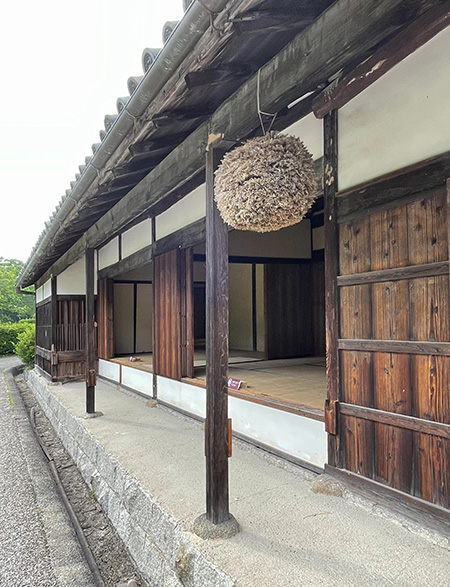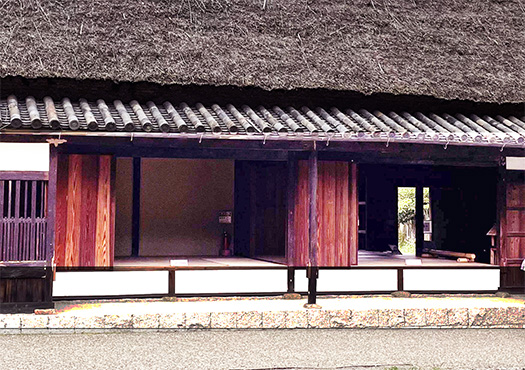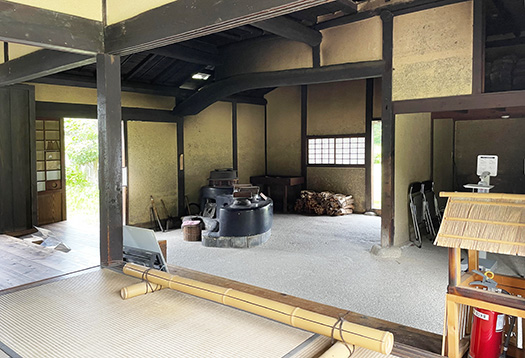


公用伝馬役という江戸期の交通制度を担っていたのがこの家の基本的な役割。
当然、現代住宅のように「個人主義」的建築目的とは相違する。
高取藩という公儀に対してその公用交通の人馬を用意していた。
以下、日本大百科全書(ニッポニカ)「伝馬役」よりの要旨引用。
〜公用伝馬役は伝馬に従事する課役。荘園制度下では馬を所有の名主らが負担。
戦国大名の下で伝馬を負担するのは道路沿いの宿駅と付近の村々。
伝馬役は一般夫役とともに銭納化され一方で営業伝馬の経営が認められた。
近世には宿駅制度設置され任務は公用通行の貨客に対する人馬提供だが、
原則として一宿ごとの継送(つぎおく)りを負担した。これが御伝馬役で、
馬役(うまえき)と歩行役(人足役)。東海道伝馬の制は1601年制定。〜
・・・江戸幕府の成立期から最重要社会インフラとして整備された。
逆に言うと、それ以前の時代には移動交通がどのようにされていたか、
たとえば源平合戦期からの全国での戦争での人馬移動にどのような兵站が
用意され実施されていたのか、研究する必要がありそう。・・・
〜多くの宿駅が36疋の伝馬常備し1638年以降は100人100疋の定置人馬制度。
中山道では50人50疋で、他の街道は25人25疋が原則である。
伝馬役負担は軒別基準が、城下町では大小間割・間口割に移行し、
平野部では馬役は持高割、歩行役は軒別割のままか小間割に移行した
この負担代償として町屋敷地「地子免除」商業上の「特権賦与」がある。
伝馬役が宿駅人馬負担で困難になり近隣農村にも課せられたのが助郷(すけごう)。
それが増大すると1764年の武蔵、上野などで中山道「伝馬大騒動」問題化した。〜
江戸期までの社会というのはこのような非合理な武家の用による
支配制度体制であって、そういう桎梏の中で運営されていた。
上述のように「騒動」まで起こっていたとすれば、
相当の負担が課せられていたことになり、その「見返り」がどうであったか、
一方で江戸期には「伊勢参り」「四国八十八箇所」などの宗教参詣が
「観光」ブームを呼んでさまざまな文化経済も沸き起こっていった。
そういうなかで「宿駅」という経済活動も活発化していたこともわかる。
京大阪から熊野・紀州などへの通行路であったことから
伊勢屋さんはどのように繁盛していたか、興味も起こる(笑)。
こういう建築の性格から前面道路に対して庇を差し出し、
その下の空間を内部的空間にする活用スタイルが見られている。
公用での移動交通に際して藩役人たちが荷役人馬の用意を待つ間、
亭主を相手に座敷縁で一服するという光景が浮かんでくる。
また、そういう公用以外のときには宿駅ビジネスとしてホテル業などの
実態もあったに相違ないと思われますね。
わたしの家系でも広島県福山近在で関連事業伝承もあり、興味は尽きません・・・。
English version⬇
The space around “Iseya,” the official messenger of the Yamato Historical Records – 19
“Oh Iseya, have you noticed any unusual movements recently?” A scene of information exchange in the mobile transportation business during the Edo period. …
The basic role of this house was to serve the transportation system of the Edo period, called “official denma yaku”.
Naturally, this is different from the “individualistic” architectural purpose of modern houses.
The Takatori clan, a public institution, provided men and horses for its official transportation system.
The following is an excerpt from the Nippon Encyclopedia of Japan (Nipponica), “Denmayaku.
〜The official denmayaku was a division of the clan that was in charge of horseback transportation. Under the manorial system, the burden was borne by the feudal lords who owned horses.
Under the feudal lords of the Warring States period, the denma yaku were assigned to inns along roads and villages in the vicinity.
The denma yaku were paid in coins as well as general husbandry, while the management of business denma was permitted.
In the early modern period, the shukueki system was established, and its duty was to provide men and horses for the official transportation of goods and passengers.
In the early modern period, a shukueki system was established, and while the duties of the shukueki were to provide men and horses for official passengers, in principle they were responsible for the transportation of passengers per inn. This was the “go-denba-yaku,” or “horseman” and “pedestrian.
There were two types of duties: horseback riding and walking (jinzoku yakuza). The Tokaido-denba system was established in 1601. 〜The Edo Shogunate was established in 1601.
The Tokaido Shinkansen was the most important social infrastructure from the early days of the Edo Shogunate.
Conversely, it is important to understand how mobile transportation was conducted in earlier periods.
For example, what kind of logistics were prepared and implemented for the movement of people and horses in wars across the country from the Genpei War period?
What kind of logistics were prepared and implemented for the movement of people and horses in wars across the country since the Genpei period, for example?
〜Many inns and stations had 36 horses, and from 1638 onward, 100 horses for 100 men were set for each inn.
On the Nakasendo, 50 men and 50 horses were used, and on other roads, 25 men and 25 horses were used in principle.
The burden of the horse messenger was divided by house, but in castle towns, it was divided between small and large houses, and in mountainous areas, it was divided between small and large houses.
In the plains, the burden for horsemen was divided according to the height of the horse, while the burden for walkers was either divided by eaves or by booths.
In return for this burden, the landowners were exempted from the use of townhouse sites and were granted commercial privileges.
As it became difficult to provide horse messengers for the station, the burden was also placed on neighboring farm villages, and this was known as sukego.
As this increased, it became a problem in 1764 when the Nakasendo “Denma Dai-riot” broke out in Musashi, Ueno, Shinano, and other areas. 〜The “Denma Riots” of 1764
Until the Edo period, society was based on this kind of irrational system of control by the warrior class.
The society until the Edo period was a ruling system based on such irrational samurai usage, and was managed under such fetters.
If there had even been a “riot” as described above, it would have been a considerable burden.
If there was even a “riot” as described above, a considerable burden was imposed, and one wonders what the “quid pro quo” was.
On the other hand, during the Edo period, religious pilgrimages to Ise, Shikoku’s 88 temples, and other places of worship became the focus of a “tourism” boom.
On the other hand, during the Edo period, religious pilgrimages to Ise and the 88 temples of Shikoku triggered a “sightseeing” boom and various cultural economic activities.
In this context, the economic activity of “shukueki” (lodging stations) also became active.
Since Iseya was a passageway from Kyoto-Osaka to Kumano, Kishu, etc., how did Iseya thrive?
It would be interesting to see how Iseya was prospering (laugh).
The building is designed with a cloister over the road in front of it, and the space under the cloister is used as an interior space.
The style of utilizing the space under the eaves as an interior space is seen in this building.
The building was used as a place for clan officials to sit with their guests while they waited for their horses to be ready for official transportation.
The scene of clan officials sitting on the edge of the tatami room with their host while waiting for their horses to be ready for official transportation comes to mind.
It is also likely that there must have been a hotel business in the area.
I am sure that there must have been a hotel business in the area.
In my family, there are related businesses in the vicinity of Fukuyama, Hiroshima Prefecture, and my interest in them is boundless….
Posted on 7月 15th, 2022 by 三木 奎吾
Filed under: 住宅マーケティング, 歴史探訪







コメントを投稿
「※誹謗中傷や、悪意のある書き込み、営利目的などのコメントを防ぐために、投稿された全てのコメントは一時的に保留されますのでご了承ください。」
You must be logged in to post a comment.